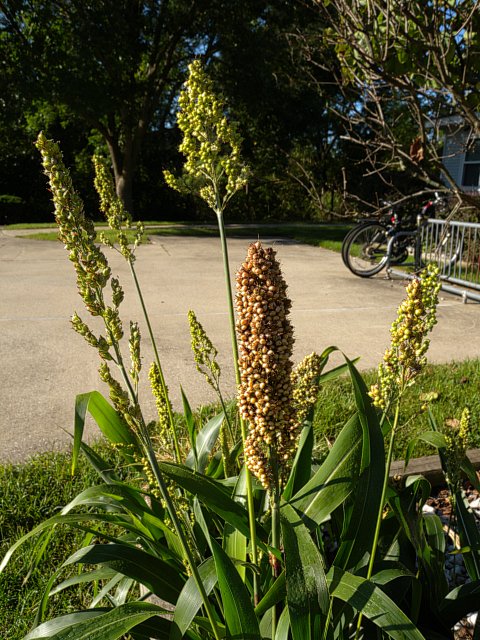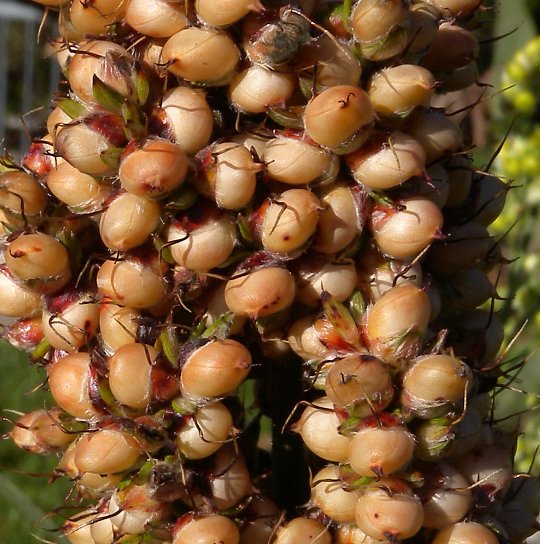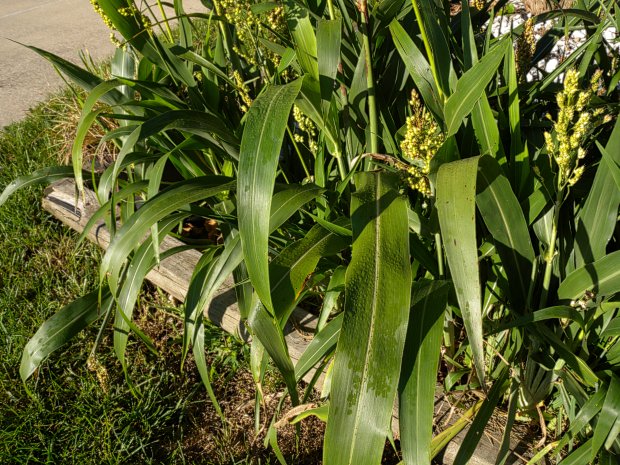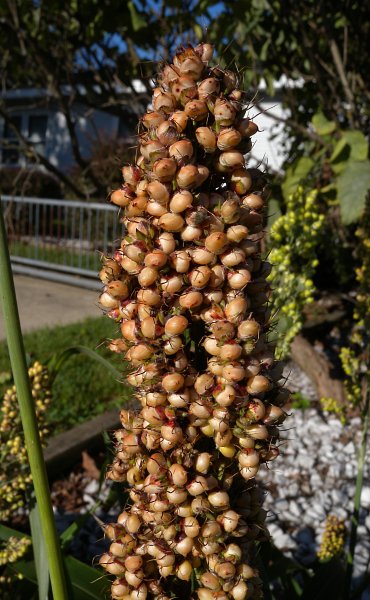Sorghum
Sorghum bicolor
Grass family (Poaceae)
Sorghum bicolor
Grass family (Poaceae)
Description:
This grass is a summer annual forming solitary or tufted leafy stems
about 2–10' tall. The stems are light green, terete, stout, hairless,
and mostly covered by the sheaths. The sheaths are light to medium
green, hairless, and open toward their apices. Alternate leaf blades
occur along the entire length of each stem underneath the
inflorescence. These leaf blades are 8–60 mm. across, 6–36" in
length, and somewhat floppy. The upper leaf blade surface is medium to
dark green and largely hairless, except occasionally for a few hairs at
the base. The lower leaf blade surface is similar, although slightly
lighter in color and duller. The midveins of the leaf blades are
greenish white and noticeably widened toward their bases. The leaf
blades clasp the stem at their bases. The ligules are usually hairy.
Each stem terminates in a panicle of paired spikelets about 6–20" long
and ovoid or oblongoid in outline. Each panicle has a central stalk
(rachis) and 1–4
ascending lateral branches developing from its nodes. The paired
spikelets tend to be aligned along these lateral branches in dense
clusters on short secondary branches and/or pedicels, which are often
finely hairy. The entire immature inflorescence is light green.
Each pair of spikelets consists of a sessile fertile spikelet that is
perfect (both male and female reproductive organs) and a pediceled
spikelet that is sterile or staminate.

The glumes (outer scales) of the sessile spikelet are 3.5–5.5 mm. long, ovate in shape, and finely ciliate along their margins. The outer surfaces of the glumes have tufts of fine hairs toward their bases or tips and they have faint vertical veins. The lemma (inner scale) of each sessile spikelet is similar in size and shape to the glumes, but somewhat softer in texture and awned. The awn of each lemma is 5–15 mm. long, early-deciduous to somewhat persistent, and irregularly curved, twisted, or bent. The floret of the sessile spikelet has an ovary with a pair of feathery stigmas and 3 stamens. The anthers of the stamens are relatively large (about 2 mm. in length) and yellow, reddish, or brown. The glumes of the pediceled spikelet are about the same length as the glumes of the sessile spikelet or slightly longer; they are narrowly lanceolate and vertically veined. The blooming period of this grass can occur from mid-summer to early autumn, lasting about 1–2 weeks. Cross-pollination of the florets is by wind. Afterwards, the panicle of paired florets becomes more compressed as it matures because its lateral branches become more erect. The fertile sessile florets develop grains that are 3–5 mm. in length, ovoid to ovoid-globoid in shape, slightly compressed (flattened) laterally, and light tan or brown at maturity. These grains are quite exposed at maturity for the typical variety of this grass (var. bicolor), but they are largely hidden for another common variety (var. drummondii). The glumes and lemmas of the spikelets are highly variable in color at maturity, depending on the cultivar; they can be greenish red, greenish purple, brown, or even black. The root system is fibrous. This grass spreads by reseeding itself.

Cultivation: This grass prefers full sun, rich loamy soil, moist to dry-mesic conditions, and warm summer temperatures. It requires a long growing season in order to fully develop.
Range & Habitat: Sorghum (Sorghum bicolor) has been found as a naturalized plant in scattered areas throughout Illinois, where it is uncommon to occasional (see Distribution Map). Habitats include cropland (especially corn fields), fallow fields, roadsides, areas along railroads, open disturbed areas, and areas around feeders for birds and wildlife. Escaped populations of this grass are rarely persistent. Sorghum was introduced into the United States as an agricultural crop. While it is cultivated throughout the world in tropical and warm-temperate areas, the wild variety of this grass is probably native to northeast Africa. In Illinois, only the typical variety (var. bicolor) and one other variety (var. drummondii) occur within the state. Disturbed habitats with exposed topsoil are strongly preferred.

Faunal Associations: Insects that feed on the foliage, roots, and other parts of Sorghum (Sorghum bicolor) include Oulema melanopus (Cereal Leaf Beetle) and other leaf beetles, larvae of Contarinia sorghicola (Sorghum Midge), Rhopalosiphum maidis (Corn Leaf Aphid) and other aphids, Heterococcus nudus (Naked Grass Mealybug), larvae of Lerodea eufala (Eufala Skipper), larvae of Nola cereella (Sorghum Nola) and other moths, and Blissus leucopterus leucopterus (Common Chinch Bug). The Insect Table has a more complete list of these insect feeders. Among vertebrate animals, birds that feed on the seeds of Sorghum include the Canada Goose, Mallard, Sandhill Crane, Greater Prairie Chicken, Bobwhite Quail, Mourning Dove, American Crow, and House Sparrow. The Bird Table has a more complete list of birds that feed on the seeds of this grass. Small amounts of the seeds are also eaten by the Deer Mouse and wild House Mouse (Whitaker, 1966). Depending on its condition, the foliage of Sorghum can be somewhat toxic to livestock and other hoofed mammalian herbivores because of nitrates and cyanide compounds. However, the fully dried foliage is edible to such animals.
Photographic Location: The yard of an apartment complex in Urbana, Illinois, near a bird and wildlife feeder. The photographed plants are unusually short (about 2' tall) for Sorghum. They are examples of Grain Sorghum (Sorghum bicolor bicolor).

Comments: Because there are so many cultivated strains of this grass, it is highly variable in appearance. The typical variety, Sorghum bicolor bicolor, tends to be less tall with wider leaf blades than Sorghum bicolor drummondii. The typical variety of this grass also has a more compact inflorescence with more exposed grains than the latter variety, and it tends to shatter less quickly with age. See Yatskievych (1999) for the taxonomy of Sorghum bicolor and its varieties as it is described here. Common names of Sorghum bicolor bicolor include Grain Sorghum, Sorgho, Broom Corn, Kafir Corn, Durra, and Feterita. Different cultivars of this variety of Sorghum have been used as a source of food for poultry and livestock, seeds for birds and wildlife, heads for brooms, and a source of sweet molasses-like syrup. Common names of Sorghum bicolor drummondii include Shatter Cane, Chicken Corn, and Sudan Grass. While this latter variety of Sorghum has been used as a source of food for poultry and livestock, it is more often a weed in sorghum and corn (Zea mays) fields. Sometimes Sudan Grass is classified as a distinct species, Sorghum sudanense (Mohlenbrock, 2001).

The glumes (outer scales) of the sessile spikelet are 3.5–5.5 mm. long, ovate in shape, and finely ciliate along their margins. The outer surfaces of the glumes have tufts of fine hairs toward their bases or tips and they have faint vertical veins. The lemma (inner scale) of each sessile spikelet is similar in size and shape to the glumes, but somewhat softer in texture and awned. The awn of each lemma is 5–15 mm. long, early-deciduous to somewhat persistent, and irregularly curved, twisted, or bent. The floret of the sessile spikelet has an ovary with a pair of feathery stigmas and 3 stamens. The anthers of the stamens are relatively large (about 2 mm. in length) and yellow, reddish, or brown. The glumes of the pediceled spikelet are about the same length as the glumes of the sessile spikelet or slightly longer; they are narrowly lanceolate and vertically veined. The blooming period of this grass can occur from mid-summer to early autumn, lasting about 1–2 weeks. Cross-pollination of the florets is by wind. Afterwards, the panicle of paired florets becomes more compressed as it matures because its lateral branches become more erect. The fertile sessile florets develop grains that are 3–5 mm. in length, ovoid to ovoid-globoid in shape, slightly compressed (flattened) laterally, and light tan or brown at maturity. These grains are quite exposed at maturity for the typical variety of this grass (var. bicolor), but they are largely hidden for another common variety (var. drummondii). The glumes and lemmas of the spikelets are highly variable in color at maturity, depending on the cultivar; they can be greenish red, greenish purple, brown, or even black. The root system is fibrous. This grass spreads by reseeding itself.

Cultivation: This grass prefers full sun, rich loamy soil, moist to dry-mesic conditions, and warm summer temperatures. It requires a long growing season in order to fully develop.
Range & Habitat: Sorghum (Sorghum bicolor) has been found as a naturalized plant in scattered areas throughout Illinois, where it is uncommon to occasional (see Distribution Map). Habitats include cropland (especially corn fields), fallow fields, roadsides, areas along railroads, open disturbed areas, and areas around feeders for birds and wildlife. Escaped populations of this grass are rarely persistent. Sorghum was introduced into the United States as an agricultural crop. While it is cultivated throughout the world in tropical and warm-temperate areas, the wild variety of this grass is probably native to northeast Africa. In Illinois, only the typical variety (var. bicolor) and one other variety (var. drummondii) occur within the state. Disturbed habitats with exposed topsoil are strongly preferred.

Faunal Associations: Insects that feed on the foliage, roots, and other parts of Sorghum (Sorghum bicolor) include Oulema melanopus (Cereal Leaf Beetle) and other leaf beetles, larvae of Contarinia sorghicola (Sorghum Midge), Rhopalosiphum maidis (Corn Leaf Aphid) and other aphids, Heterococcus nudus (Naked Grass Mealybug), larvae of Lerodea eufala (Eufala Skipper), larvae of Nola cereella (Sorghum Nola) and other moths, and Blissus leucopterus leucopterus (Common Chinch Bug). The Insect Table has a more complete list of these insect feeders. Among vertebrate animals, birds that feed on the seeds of Sorghum include the Canada Goose, Mallard, Sandhill Crane, Greater Prairie Chicken, Bobwhite Quail, Mourning Dove, American Crow, and House Sparrow. The Bird Table has a more complete list of birds that feed on the seeds of this grass. Small amounts of the seeds are also eaten by the Deer Mouse and wild House Mouse (Whitaker, 1966). Depending on its condition, the foliage of Sorghum can be somewhat toxic to livestock and other hoofed mammalian herbivores because of nitrates and cyanide compounds. However, the fully dried foliage is edible to such animals.
Photographic Location: The yard of an apartment complex in Urbana, Illinois, near a bird and wildlife feeder. The photographed plants are unusually short (about 2' tall) for Sorghum. They are examples of Grain Sorghum (Sorghum bicolor bicolor).

Comments: Because there are so many cultivated strains of this grass, it is highly variable in appearance. The typical variety, Sorghum bicolor bicolor, tends to be less tall with wider leaf blades than Sorghum bicolor drummondii. The typical variety of this grass also has a more compact inflorescence with more exposed grains than the latter variety, and it tends to shatter less quickly with age. See Yatskievych (1999) for the taxonomy of Sorghum bicolor and its varieties as it is described here. Common names of Sorghum bicolor bicolor include Grain Sorghum, Sorgho, Broom Corn, Kafir Corn, Durra, and Feterita. Different cultivars of this variety of Sorghum have been used as a source of food for poultry and livestock, seeds for birds and wildlife, heads for brooms, and a source of sweet molasses-like syrup. Common names of Sorghum bicolor drummondii include Shatter Cane, Chicken Corn, and Sudan Grass. While this latter variety of Sorghum has been used as a source of food for poultry and livestock, it is more often a weed in sorghum and corn (Zea mays) fields. Sometimes Sudan Grass is classified as a distinct species, Sorghum sudanense (Mohlenbrock, 2001).